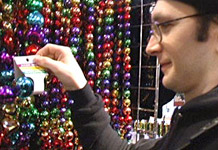Mardis Gras: Made in China


Every year, thousands of drunken revelers descend upon the streets of New Orleans, eagerly flashing their breasts for cheap colorful beads. But where do those beads come from? This question prompted director David Redmon to travel to China in order to make Mardis Gras: Made in China. His documentary contrasts the hedonistic excesses of Mardis Gras with the horrific conditions in Fuzhou China, were factories consisting predominantly of young women, toil under draconian conditions in order to produce beads. It's a fascinating documentary on some levels, and a much too simplistic and repetitive one on some others. Redmon would have made a better film just by focusing on China and ignoring Mardis Gras, which is where he falters a bit.
In Fuzhou, Redmon interviews Roger Wong, owner of the Tai Kuen Bead Factory, which is more like a compound. In China, people are so poor that they often live at their workplaces. Tai Kuen is a walled in complex (to keep people out, not in) with cramped housing and large kitchens. Over 95% of the workers are female, and many are younger than 18. They make little money (by American standards, which is a key point to remember) and toil under what looks like extremely hazardous working conditions. Wong comes across as a charismatic dictator, spouting off ideas and beliefs that in America, were left behind decades ago. He rewards his workers for meeting their quotas, but also punishes them in fines when they do not. They are fined for talking to each other during working hours, and going to the bathroom too much (whatever that may be) is frowned upon. Because labor is so plentiful, everything is made by hand. This includes melting the beads together, which Redmon shows one young woman do in real time. Another shot shows burned fingers. Women pull beads out of large machines, paint figurines, and package beads together. It looks and feels like a glimpse into America from the past. It is this section of Mardis Gras that deserves attention. Wong's attitudes towards his employees and women are demeaning and backwards, and hopefully, as China industrializes, will change for the better.
Redmon is much less successful in New Orleans. He asks people the ambiguous question "where do beads come from" instead of something clearer like "where do you think they were made?" He is obviously trying to to bait people to comment upon how horrible it is that young women work 14 hours a day to produce something that typically ends up in the trash (when the Chinese women learn how American women get beads, they are often quite amused). But Redmon is pretty repetitive, and never probes his American subjects too deeply. He doesn't really have anything insightful to say about globalization, and doesn't come to any resolution on this issue. Mardis Gras: Made in China is good in that it sheds light on something that his happening, but fails to recommend anything in order to stop it. Worse, asking people on the street, especially drunk people, will never yield great results.
Mardis Gras is also a call to arms on an emotional level, not necessarily an economic one. Redmon is relying on viewer outrage at the factory conditions in China, without providing much context. Lack of context hurts the film, because there is too much missing. Yes, ten cents an hour is piddly, but that's here in America. He never mentions what that amount could buy in China (presumably a lot more). Remember, China is a third world country. The only person her interviews who thinks along these lines is identified (almost derisively) as an MBA student (but the fact that he does allow the view to air says something). Redmon's worse lapse in logic comes when he implies that young women toil all day for something that people just throw away. While the sequence may be true, he forgets that at some point, somebody riding a float or standing in a building bought those beads. What they choose to do with them afterwards is their own choice. Otherwise, people can make the same argument about nearly every consumer good that ends up in the trash.
Finally, strangest decision was to show women's breasts. This automatically prevents teenagers from seeing the film (well, theoretically). It's not that hard to pixilate boobs, and it's a shame he didn't. This film is something that schools could potentially use to demonstrate globalization, but the nudity automatically restricts the viewership.